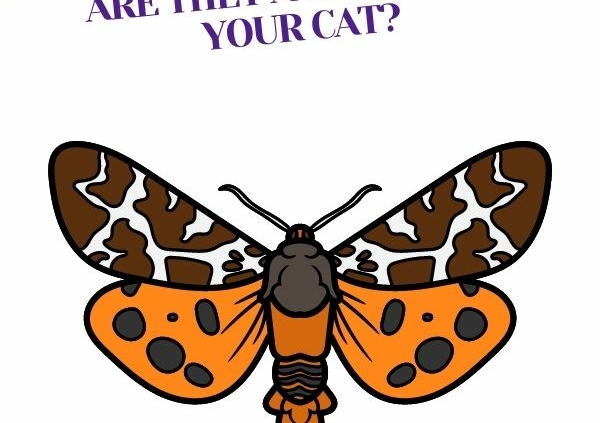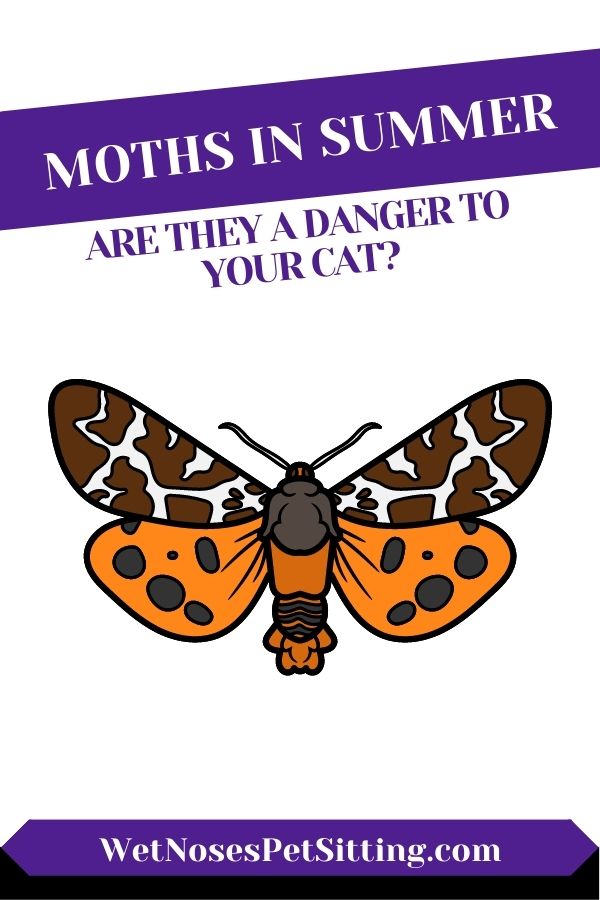Moths in Summer, Are They a Danger to Your Cat?
Moths in Summer, Are They a Danger to Your Cat?
Here in Eastern Colorado, Nebraska, Oklahoma, and Kansas, May and June tend to be the time when the Miller Moth begins their migration. This year with our cooler wetter spring we will see more than the usual population and for a longer period before they move westward toward the mountains.

Ben Sale from Stevenage, UK, CC BY 2.0 <https://creativecommons.org/licenses/by/2.0>, via Wikimedia Commons
They navigate by the stars and moon so by keeping your outside lights off and your indoor blinds closed, you can minimize the likelihood of them coming in doors. Because they flutter and flounce around our homes your cat is going to be stalking them and very likely eating them. While they may be a nuisance to us we should see if they are a danger to our cats.
The “Miller moth” is NOT toxic to your cat, if your cat eats more than one or two you probably won’t notice anything different with them. However, there are some pet parents who are noticing their kitty is getting sick from eating too many of them. How many is too many? It really depends on the individual cat.
The fact is that they are different from your regular cat’s diet and so they can cause digestive issues such as vomiting and diarrhea in some felines. Additionally, the moths could have been exposed to insecticides and this can be dangerous for your cat.
What Moths Are Toxic to Cats?
The Garden Tiger Moth also called The Great Tiger Moth are toxic to cats, however most cats seem to know this and generally avoid them. This includes their caterpillar form.
The Tiger Moth does carry a harmful virus that can be deadly for cats. So, familiarize yourself with these two moth species so that you can have a better understanding of what is in your specific region and can keep your cat safely away from them.
Mothballs, used to repel moths, are extremely toxic to kitty’s! Use cat friendly products like lavender and cedar instead to protect fabrics and clothing or try one of these moth traps that are safe and effective around pets and children.
Generally speaking your cat should be fine playing with and occasionally eating a moth. However you can help them to avoid ingesting one by offering them tasty treats and making sure that they are not hungry, this may lessen their desire to chomp them down! Be sure that you are giving them enough one on one play time to fulfill their need to pounce, jump and attack.
If you have a lot of moths in and around your home and your cat is lethargic, vomiting and generally not themselves be sure to take them to your veterinarian for a thorough check up so that you can get them back to their normal, fun, and playful selves!
What Other Insects Are Harmful to Cats?
In Eastern Colorado, there are several insects that can potentially be harmful or poisonous to cats if they are bitten or stung. While these insects may not be exclusive to Colorado, they are commonly found in the region. It’s important to note that most insect bites or stings result in localized reactions such as swelling, pain, or discomfort, but severe reactions are rare.
- Black Widow Spider: Black widow spiders are venomous and can be found in Eastern Colorado. Their bite can cause muscle pain, tremors, and in severe cases, can be fatal, although fatalities are rare.
- Brown Recluse Spider: Brown recluse spiders are also venomous and found in Colorado. Their bite can cause tissue necrosis, resulting in an open wound that may take a long time to heal.
- Bark Scorpions: While scorpions are not commonly found in Colorado, Eastern parts of the state might have a few species. The bark scorpions can deliver venomous stings that can cause pain, swelling, and other localized symptoms.
- Bees and Wasps: Multiple species of bees and wasps can be found in Eastern Colorado, including honeybees, bumblebees, and various wasp species. If stung, cats may experience pain, swelling, and allergic reactions.
Thankfully not all of these are commonly found in Eastern Colorado, Nebraska, Oklahoma, and Kansas. And those that are tend to stay away from people. But we all know how cats are, they’ll get into places we didn’t imagine they could. If you suspect your cat has been bitten or stung, it is best to consult with a veterinarian for appropriate guidance and treatment.
I hope this information has helped you understand what moths are toxic and what to watch out for in your cat’s in order to have a beautiful safe summer!
















